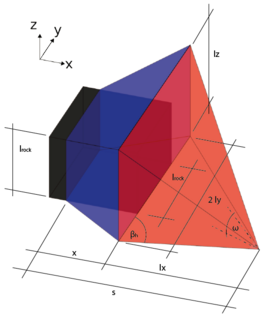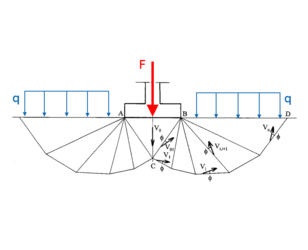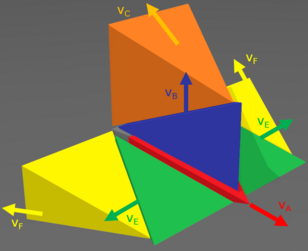The philosophy of this approach to model the rock-dam interaction lies in the application of basic work-energy principles and hard contact laws to a rigid rock and purely plastic soil. This eliminates the need to calculate the highly complex stress and strain state during impact. The algorithm mainly consists of a soil compaction and resistance model. The soil compaction model uses a mass conservation criterion to calculate the soil redistribution and densification during the impact. The soil resistance model uses an upper bound solution to calculate the limit load of a representative bearing capacity mechanism triggered by the penetration of the rock. In addition, the model introduces a source of rotational energy dissipation due to load eccentricity and lateral soil compaction of the soil by the rotating rock. The result is an interaction model, which is applicable to impacts of any (convex) rock shape, dam geometry and kinetic energy.
Soil Compaction Model ¶

The general modelling procedure is based on mass conservation and soil densification. The mass of soil that is displaced by the rock is evenly distributed in the compacted zone and increases its density accordingly. Mass conservation requires that:
$$ V_{rock} \cdot \rho_1 = \left ( V_{plug}-V_{rock} \right ) \cdot \rho_2 $$
where $\rho_1$ is the initial density of the dam material, $\rho_2$ is its compacted (final) density. The amount of material displaced by the rock is:
$$ V_{rock} = x \cdot l_{rock}^2 $$
where $x$ is the penetration depth and $l_{rock}$ is the edge length of the cubic rock. This leads to a "plug" volume of:
$$ V_{plug} = \frac{x}{3} \cdot \left [ 2 \cdot l_y \cdot l_z + l_{rock}^2 + \frac{l_{rock}}{2} \cdot \left ( 2 \cdot l_y + l_z \right ) \right ] + \frac{2 \cdot l_y \cdot l_z \cdot l_x}{3} $$
where $l_x$, $l_y$, $l_z$ are dimensions of the compacted zone.
$$ l_x = s - x, \; l_y = \frac{l_x}{\tan{\beta_{h}}}, \; l_z = l_x \cdot \tan{\omega} $$
The equations above combined yield a cubic polynomial for the depth of the compaction front $s$ as a function of the penetration depth $x$. This polynomial equation has three roots (solutions) which can be found analytically. Two of the roots are imaginary and only the real root has physical significance.
Soil resistance model ¶
The soil resistance is calculated with an upper bound solution. The approach is based on a bearing capacity problem of a strip foundation. The soil is homogeneous, isotropic, with a Mohr Coulomb plasticity model and associated flow rule ($\Psi = \phi$).


The rate of work done by external forces $\Delta W_{ext}$ is equal to the rate of energy dissipation $\Delta D_{int}$ in the kinematically admissible velocity field.
$$ \Delta W_{ext} = \Delta D_{int} $$
The first source of incremental external work results from the self-weight of the soil prisms
$$ \Delta W_{sf} = \sum V_i \cdot \gamma_i \cdot v_{i,z} $$
where $V_i$ is the volume and $\gamma_i$ is the density of the soil prism and $v_{i,z}$ is the velocity component of the soil body $i$ in the direction of the gravitational force vector.
The second source of incremental external work comes from the surcharge load. For impacts below the dam crest, this surcharge load corresponds to the overburden pressure due to the overlying soil.
$$ \Delta W_{sc} = \sum V_{i,sc} \cdot \gamma_1 \cdot v_{i,z} $$
where $V_{i,sc}$ is the volume of the overlying soil block of soil prism $i$, $\gamma_1$ is the initial density of the soil material and $v_{i,z}$ is the velocity component of soil prism $i$ in the direction of the gravitational force vector.
The last component of the incremental external work comes from the impact force exerted by the rock on the dam structure.
$$ \Delta W_{im} = F_{impact} \cdot v_0 $$
where $F_{impact}$ is the unknown impact force and $v_0 = 1$ is the virtual unit velocity of the rock.
The only source of incremental internal dissipated energy comes from the cohesion at the discontinuity surfaces between the moving soil bodies.
$$ \Delta D = \sum c \cdot A_{i,j} \cdot v_{i,j} $$
where $c$ is the cohesion, $A_{i,j}$ is the surface area of the shear plane between soil prism $i$ and $j$ and $v_{i,j}$ is the velocity along the velocity discontinuity between soil bodies $i$ and $j$.
All equations above combined yield the full upper bound solution, where the only unknown is the impact force.
$$ F_{impact} = \frac{\Delta D - \Delta W_{sf} - \Delta W_{sc}}{v_0} $$
Implementation in trajectory model ¶
The resulting force $F_{impact}$ for a given time step is applied to the rock by conservation of momentum. Thus, the resulting penetration depths can be calculated after full time integration, when the rock has lost all of its original kinetic energy.
In case of a rebound with a certain conservation of kinetic energy, the rock experiences a discontinuous change of velocity according to hard contact laws. A rebound is initiated as soon as the rock hits a certain predefined maximum penetration depth. This depth is an empirical relation derived by [Gerber, 2019] and is based on the elastic theory of Hertz.
$$ d_{\Sigma}^{max} = 0.16 \cdot M^{1/4} \cdot M_E^{-0.4} \cdot |V^{\perp}|^{0.8} $$